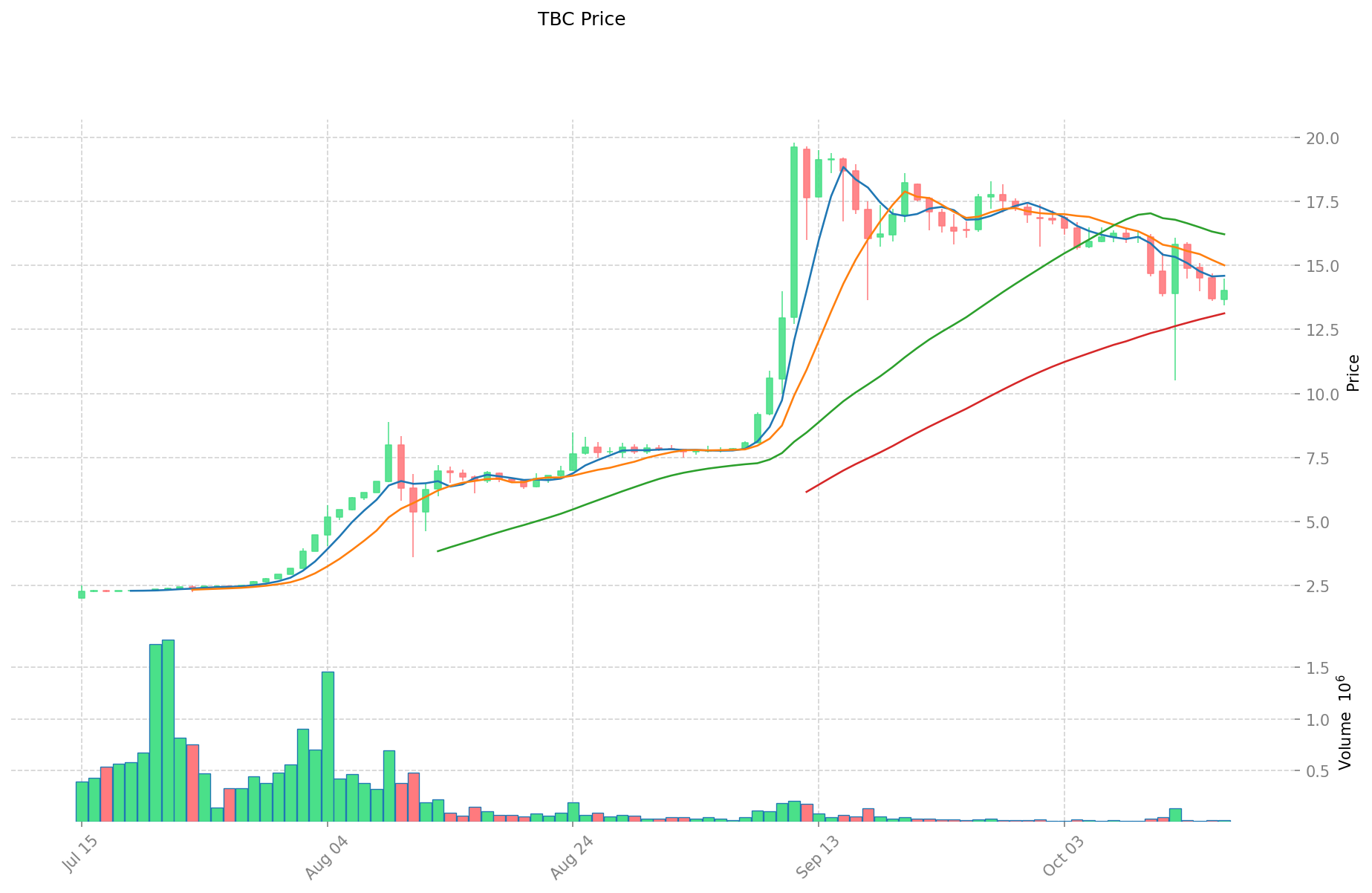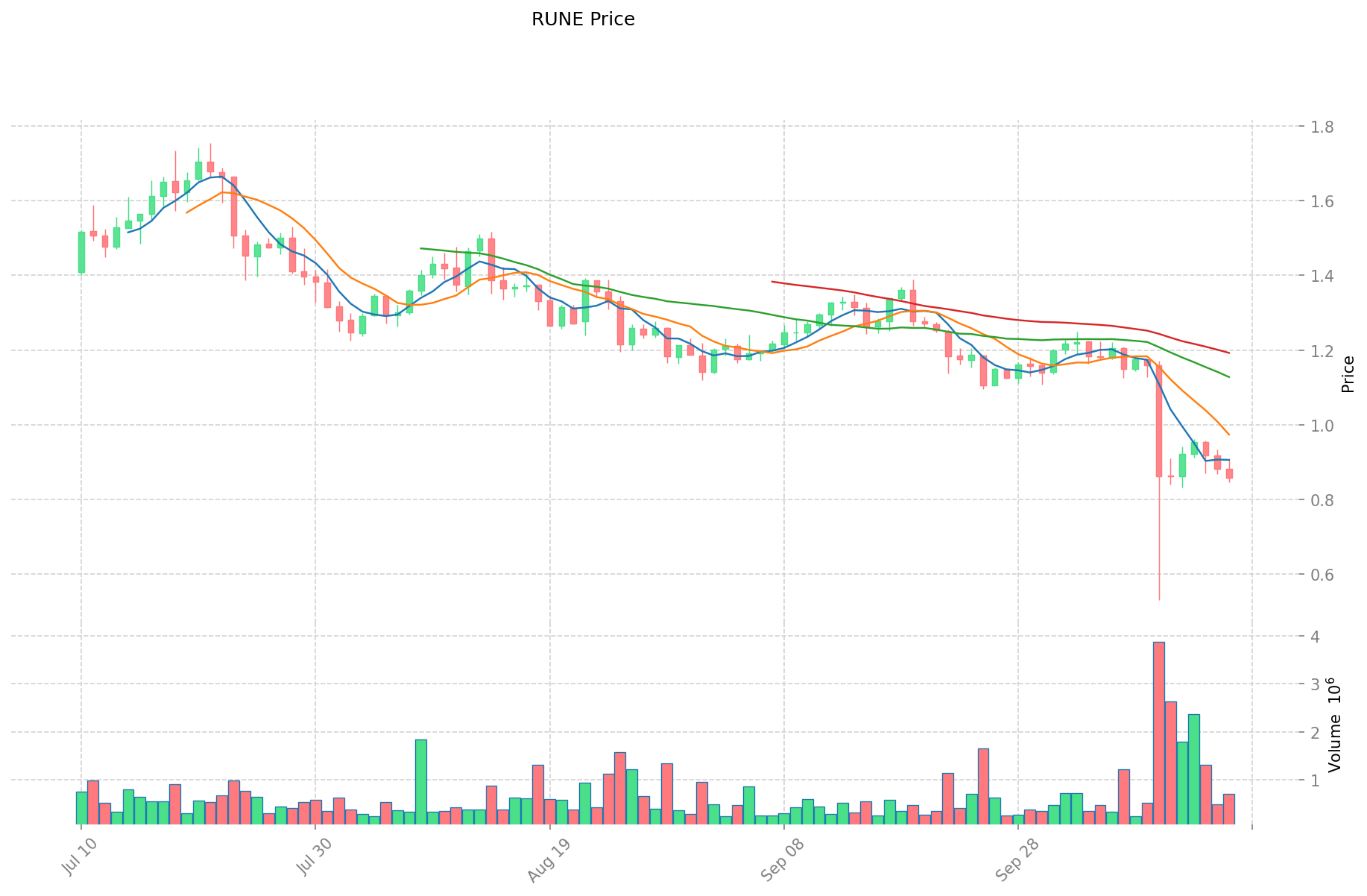TBC vs RUNE: The Battle for Blockchain Dominance in Cross-Chain Asset Transfer
Introduction: TBC vs RUNE Investment Comparison
In the cryptocurrency market, the comparison between TBC and RUNE has always been a topic that investors cannot ignore. The two not only show significant differences in market cap ranking, application scenarios, and price performance, but also represent different positions in crypto assets.
TBC (TBC): Since its launch, it has gained market recognition for its pioneering role in the Bitcoin Virtual Machine (BVM) and scalable BTC smart contract layer solution.
RUNE (RUNE): Launched in 2019, it has been hailed as a highly optimized multi-chain ecosystem, facilitating protocol-level chain transactions and order matching.
This article will comprehensively analyze the investment value comparison between TBC and RUNE, focusing on historical price trends, supply mechanisms, institutional adoption, technological ecosystems, and future predictions, attempting to answer the question that investors are most concerned about:
"Which is the better buy right now?"
I. Price History Comparison and Current Market Status
TBC and RUNE Historical Price Trends
- 2025: TBC reached its all-time high of $19.8 on September 11, 2025.
- 2025: RUNE experienced significant volatility, with a 52-week high of $5.45.
- Comparative Analysis: In the current market cycle, TBC has shown stronger performance, maintaining a price above $14, while RUNE has declined to below $1.
Current Market Situation (2025-10-17)
- TBC current price: $14.044
- RUNE current price: $0.8605
- 24-hour trading volume: TBC $280,130.14 vs RUNE $626,972.24
- Market Sentiment Index (Fear & Greed Index): 28 (Fear)
Click to view real-time prices:
- View TBC current price Market Price
- View RUNE current price Market Price


II. Core Factors Affecting TBC vs RUNE Investment Value
Supply Mechanism Comparison (Tokenomics)
- TBC: Server progress influences equipment demand, driving corresponding material prices
- RUNE: The proportion of I5SR affects spiritual returns, with higher I5SR ratios resulting in lower spiritual gains
- 📌 Historical Pattern: Despite preparations, mineral prices surge when many players rush for gems, showing supply-demand dynamics driving price cycles
Institutional Adoption and Market Applications
- Team Composition: Complete team buffs significantly impact attribute weights between T4 and T6 levels
- Attribute Optimization: Different initial states affect attribute priority, creating varied investment strategies
- Server Demographics: Expansion versions experience rapid decline while max-level era servers see population surges
Technical Development and Ecosystem Construction
- TBC Technical Features: Better class balance and new skills compared to classic versions
- Equipment Valuation: Systematic approaches for evaluating gear upgrades based on point-value systems
- Ecosystem Comparison: Despite technical improvements in TBC and Wrath of the Lich King, player retention varies
Macroeconomic and Market Cycles
- Resource Preparation: Even with six months of preparation, market demand can cause direct price increases
- Manufacturing Economy: Server progression directly impacts crafted equipment demand
- Material Value Fluctuations: Attribute weighting changes between different gear tiers affect material investment priorities
III. 2025-2030 Price Prediction: TBC vs RUNE
Short-term Prediction (2025)
- TBC: Conservative $7.33-$14.10 | Optimistic $14.10-$16.50
- RUNE: Conservative $0.51-$0.86 | Optimistic $0.86-$1.00
Mid-term Prediction (2027)
- TBC may enter a growth phase, with an estimated price range of $10.37-$23.88
- RUNE may enter a growth phase, with an estimated price range of $0.78-$1.54
- Key drivers: Institutional capital inflow, ETFs, ecosystem development
Long-term Prediction (2030)
- TBC: Base scenario $15.50-$29.25 | Optimistic scenario $29.25-$41.53
- RUNE: Base scenario $1.05-$1.72 | Optimistic scenario $1.72-$1.84
Disclaimer
TBC:
| 年份 | 预测最高价 | 预测平均价格 | 预测最低价 | 涨跌幅 |
|---|---|---|---|---|
| 2025 | 16.50051 | 14.103 | 7.33356 | 0 |
| 2026 | 21.7284921 | 15.301755 | 10.25217585 | 8 |
| 2027 | 23.8845093795 | 18.51512355 | 10.368469188 | 31 |
| 2028 | 27.3477632395275 | 21.19981646475 | 16.9598531718 | 50 |
| 2029 | 34.226043691515637 | 24.27378985213875 | 20.875459272839325 | 72 |
| 2030 | 41.534881815994615 | 29.249916771827193 | 15.502455889068412 | 108 |
RUNE:
| 年份 | 预测最高价 | 预测平均价格 | 预测最低价 | 涨跌幅 |
|---|---|---|---|---|
| 2025 | 0.999224 | 0.8614 | 0.508226 | 0 |
| 2026 | 1.19079936 | 0.930312 | 0.89309952 | 8 |
| 2027 | 1.537805736 | 1.06055568 | 0.7848112032 | 23 |
| 2028 | 1.623975885 | 1.299180708 | 0.68856577524 | 51 |
| 2029 | 1.973130700275 | 1.4615782965 | 1.14003107127 | 70 |
| 2030 | 1.837569313274625 | 1.7173544983875 | 1.047586244016375 | 100 |
IV. Investment Strategy Comparison: TBC vs RUNE
Long-term vs Short-term Investment Strategies
- TBC: Suitable for investors focused on BTC ecosystem expansion and smart contract potential
- RUNE: Suitable for investors interested in multi-chain liquidity and cross-chain operations
Risk Management and Asset Allocation
- Conservative investors: TBC: 60% vs RUNE: 40%
- Aggressive investors: TBC: 70% vs RUNE: 30%
- Hedging tools: Stablecoin allocation, options, cross-currency portfolios
V. Potential Risk Comparison
Market Risks
- TBC: Volatility tied to Bitcoin market sentiment
- RUNE: Susceptibility to broader DeFi market trends
Technical Risks
- TBC: Scalability, network stability
- RUNE: Protocol security, cross-chain bridge vulnerabilities
Regulatory Risks
- Global regulatory policies may impact both differently, with potential stricter oversight on cross-chain protocols
VI. Conclusion: Which Is the Better Buy?
📌 Investment Value Summary:
- TBC advantages: Strong Bitcoin ecosystem integration, potential for BTC smart contract adoption
- RUNE advantages: Multi-chain liquidity provision, established cross-chain infrastructure
✅ Investment Advice:
- New investors: Consider a balanced approach, leaning towards TBC for its Bitcoin ecosystem exposure
- Experienced investors: Explore a strategic mix, potentially overweighting TBC based on Bitcoin's market dominance
- Institutional investors: Evaluate both for portfolio diversification, with emphasis on TBC's potential in the evolving Bitcoin landscape
⚠️ Risk Warning: Cryptocurrency markets are highly volatile. This article does not constitute investment advice. None
VII. FAQ
Q1: What are the main differences between TBC and RUNE? A: TBC focuses on Bitcoin ecosystem expansion and smart contracts, while RUNE specializes in multi-chain liquidity and cross-chain operations. TBC has shown stronger price performance recently, maintaining a price above $14, while RUNE has declined to below $1.
Q2: Which cryptocurrency has shown better price performance in the current market cycle? A: In the current market cycle, TBC has shown stronger performance, maintaining a price above $14, while RUNE has declined to below $1.
Q3: What are the long-term price predictions for TBC and RUNE by 2030? A: By 2030, TBC is predicted to reach $15.50-$29.25 in the base scenario and $29.25-$41.53 in the optimistic scenario. RUNE is predicted to reach $1.05-$1.72 in the base scenario and $1.72-$1.84 in the optimistic scenario.
Q4: How do the supply mechanisms of TBC and RUNE differ? A: TBC's supply is influenced by server progress and equipment demand, while RUNE's supply is affected by the I5SR ratio, which impacts spiritual returns.
Q5: What are the main risk factors for TBC and RUNE? A: For TBC, main risks include volatility tied to Bitcoin market sentiment, scalability, and network stability. For RUNE, risks include susceptibility to broader DeFi market trends, protocol security, and cross-chain bridge vulnerabilities.
Q6: How should investors allocate their portfolio between TBC and RUNE? A: Conservative investors might consider allocating 60% to TBC and 40% to RUNE, while aggressive investors might allocate 70% to TBC and 30% to RUNE. However, individual allocations should be based on personal risk tolerance and investment goals.
Q7: Which cryptocurrency is considered a better buy for new investors? A: For new investors, a balanced approach leaning towards TBC is suggested due to its strong Bitcoin ecosystem integration and potential for BTC smart contract adoption. However, investors should conduct their own research and consider their risk tolerance before making investment decisions.
Share
Content